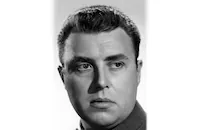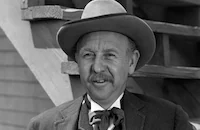The Great Sioux Uprising
Brief Synopsis
Cast & Crew
Lloyd Bacon
Jeff Chandler
Faith Domergue
Lyle Bettger
Peter Whitney
Stacy S. Harris
Film Details
Technical Specs

Synopsis
During the Civil War, livery stable owner Joan Britton learns that Union forces are in desperate need of horses and asks her cook, Heyoka, to help her find the great herds kept by the Sioux. On their way to the Sioux village, Joan and Heyoka are secretly tracked by horse trader Stephen Cook, who wants the valuable horses for himself. At the village, Chief Red Cloud tells Joan that the horses, a gift from the Nez Perce, are sacred and therefore not for sale. After eavesdropping from behind a tree, Cook decides to steal the horses, and returns later with his men. The Indians try unsuccessfully to stop the thieves, and a horse and brave are shot in the skirmish. Physician Jonathan Westgate then arrives in the Sioux village and helps Red Cloud to heal the injured horse. Red Cloud explains that the tribe has elected not to pursue the horse thieves, fearing that the Cavalry might come and appropriate their remaining land. Red Cloud gives Jonathan a horse, and the physician promises to help locate the thieves. In town, Jonathan befriends blacksmith Ahab Jones and soon falls in love with Joan. Explaining that he gave up medicine because he was unable to help many dying Union soldiers, Jonathan sets up shop as the town veterinarian. That day, Cook arrives with three hundred horses, which he claims he bought from another dealer. Jonathan, however, removes an arrowhead from the horse of Cook's foreman and immediately suspects him in the horse theft. Later, Jonathan learns that the local horse ranchers are angry because Cook's men have been intimidating other horsemen attempting to sell to the Cavalry. Jonathan suggests that the ranchers journey to a nearby fort together to explain the situation to Major McKay, but Cook foils this plan by kidnapping Jonathan and persuading the ranchers to return home. When one of the ranchers defies him, Cook has one of his men stab him and places Jonathan's scalpel near the body. Later, while he is being held captive at Cook's ranch, Jonathan performs an operation on Cook, saving his life. As soon as Jonathan is released, the townspeople brand him a murderer and try to hang him. Jonathan escapes and tells Red Cloud that he has seen a stolen Sioux horse at Cook's ranch. After Red Cloud agrees to help clear Jonathan of the murder charge, Cook discovers the doctor's plan and gets rid of the horse. Joan informs Red Cloud of this, but the chief accuses her of setting up the theft of the tribe's horses. The chief takes Joan and Jonathan to an Indian council, where Stand Watie, a Cherokee Confederate general, tries to convince Sioux, Oglala, Nez Perce, Cheyenne, Crow and Blackfoot leaders to join the Southern forces. As he is white, Jonathan is allowed to speak only after surviving a bludgeoning by a group of braves, and he expounds upon the Northern belief that no one is inferior because of skin color. Meanwhile, Cook and his men raid the remaining Sioux herd, killing a child in the process. Horrified, Red Cloud accuses Jonathan of treachery and sends his men to drive away the horse thieves. Hoping for assistance, Cook tells the fort that the Indians have raided a herd of horses that he purchased. After Joan and Jonathan escape from the Sioux village, Jonathan finds Cook and defeats him in a fistfight. Jonathan finally convinces McKay of Cook's guilt, after which the major promises Red Cloud that the Cavalry will punish the murderers and pay for the horses. Satisfied, Red Cloud agrees to maintain the peace. Later, Jonathan enlists in the Union army and promises to marry Joan upon his return.

Director

Lloyd Bacon
Cast

Jeff Chandler

Faith Domergue

Lyle Bettger

Peter Whitney
Stacy S. Harris

Walter Sande
Stephen Chase
John War Eagle

Glenn Strange

Charles Arnt
Julia Montoya
Ray Bennett
Dewey Drapeau
Boyd Red Morgan
Lane Bradford
Jack Ingram
Clem Fuller
Virginia Mullen
Monte Montague
George Taylor
James Van Horn
Gilbert E. Conner
Ed Rand
Edmund Cobb
Ned Davenport
Kermit Maynard
Carl Andre
Philo Mccullough
Stanley Blystone
Buddy Roosevelt
Al Wyatt
Earl Conner
Duane E. Conner
Howard B. Swartz
Harvey Matlock
Francis Shillal
Mel Lambert
Clarence Burke
Tom Mcgonigle
Mike Shaughnessy
Sarah O'halloran
Sol Berg
Crew
Glenn E. Anderson
Frank Artman
Gladys Atwater
Gladys Atwater
J. Robert Bren
J. Robert Bren
Leslie I. Carey
Albert J. Cohen
Hugh Cummings
Edward Curtiss
William Fritzsche
Russell A. Gausman
Joseph Gershenson
Maury Gertsman
Frank Gill Jr.
Leonard Goldstein
Alexander Golitzen
Bernard Herzbrun
Jesse Hibbs
Joe Kish
Madison Lacey
Melvin Levy
George Lollier
Rusty Meek
John Mehl
John Peters
Robert Pierce
George Shrader
Art Siteman
Joan St. Oegger
Alfred Sweeney
Bill Thomas
Paul Uhl
Bud Westmore
Frank Wilkenson

Film Details
Technical Specs

Quotes
Trivia
Notes
The working title of this film was Sioux Uprising. A September 1952 Hollywood Reporter news item reports that Stephen McNally was originally cast as "Stephen Cook," but was replaced by Lyle Bettger after McNally's wife fell ill. A July 26, 1952 Los Angeles Times news item notes that Alexis Smith was originally scheduled to play the female lead. According to a preliminary Universal cast listing, Rosa Rey was to appear in the role of "Heyoka." Studio publicity materials state that local Oregon Native Americans were cast as Sioux in the film, and identify the tribes as Walla Walla, Cayuse and Umatilla. According to contemporary sources, the film was shot on location in Pendleton and Portland, OR.
As depicted in the film, Stand Watie (1806-1871) was a Cherokee leader who sided with the Confederacy during the early years of the Civil War, and commanded two regiments of the Cherokee Mounted Rifles. On May 10, 1864, he received the commission of brigadier general, becoming the first Native American so promoted. In 1865, after the U.S. government began building a road from Wyoming's Ft. Laramie to Montana, Red Cloud (1822-1909), chief of the Bad Face band of the Oglalas and leader of Sioux and Cheyenne bands, led his braves in attacks on U.S. forces designed to stop the flow of settlers. During the next two years, in what was dubbed Red Cloud's War, the warrior and his braves captured Army construction troops on the Bozeman Trail and killed many whites. In 1868, Red Cloud agreed to have his people settled on the Red Cloud Agency in Nebraska.












